#“The Original Gothic Gangster”
Text
DO YOU KNOW THIS WRESTLER
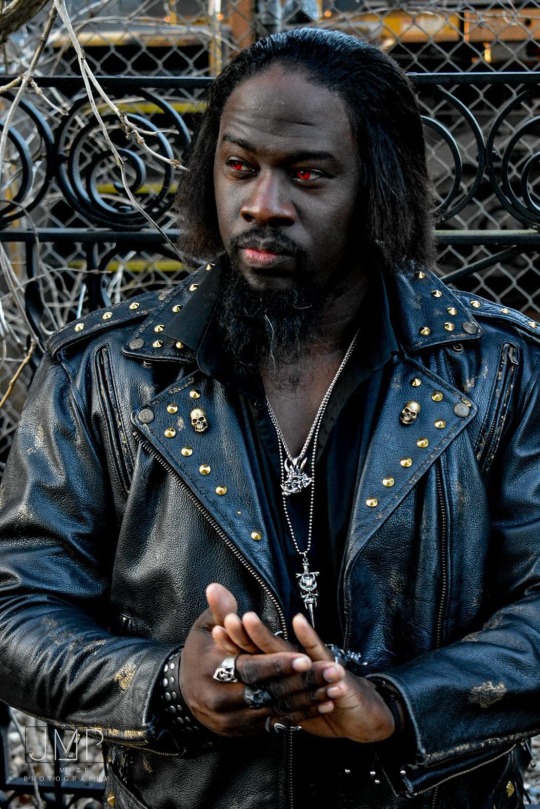
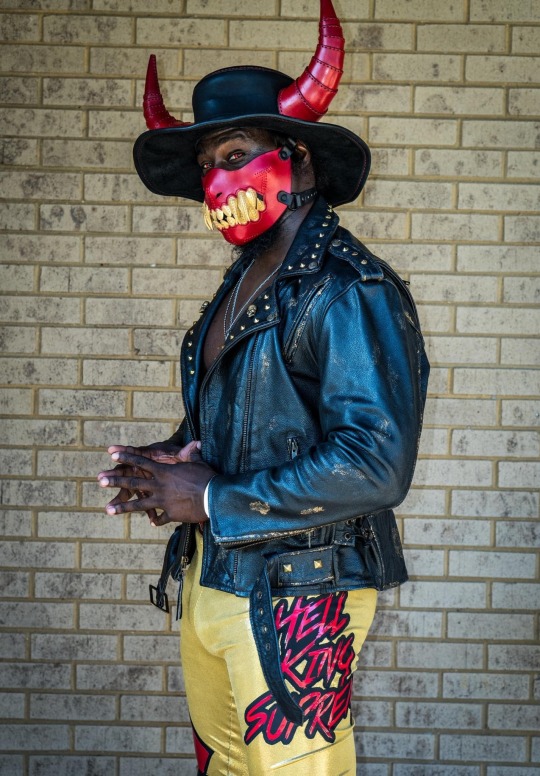
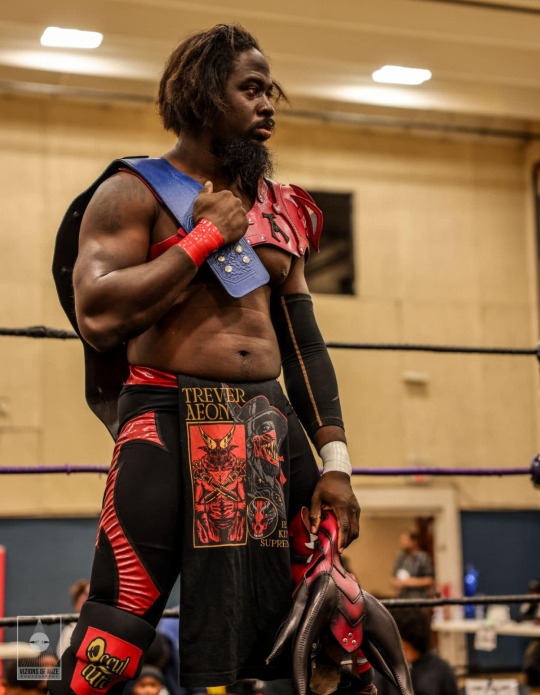
#“The Original Gothic Gangster”#“Hell King Supreme”#“The Devil”#“Doom”#polls#Do You Know This Wrestler?
8 notes
·
View notes
Note
What are your top 3 favorite clans? Either to make a character for or to use as a Storyteller? :3
Oooooooh, thanks for asking! I'll do these in reverse order, build up to the best.
Number three: Malkavian
My original faves, and a clan about whom I have some sTRoNg oPiNIoNs. See, the thing with Malkavians is that for years and years and years it felt like nobody thought for two minutes about how the rules for Derangements work. Too many Malks were played as hapless victims of their insanity, driven to ooky-kooky comic relief bullshit behaviour or dark tormented scary deep mental anguish all the time - and that's not how it works. The Malkavian Derangement was incurable, as in it would never be removed - it was not insurmountable!
Derangements could be overcome through the expenditure of Willpower, scene by scene. Willpower could be recycled through a careful choice of Nature and Demeanour to indulge. Malkavians were about powering through, being a dangerous and cogent master of the mind whammy, surfing your own mind's wild tides with gritted teeth and every now and then, when it didn't matter so much, when you had the luxury of rest, unclenching your jaw and letting the madness take you.
Therese Voerman is my poster girl for what a Malkavian should be: she's competent, ruthless, and clearly has problems that she's keeping under control through sheer cognitive heft/letting Jeanette out to play when it's all too much.
Anyway. Malks. Love the Disciplines, love the Network, love the visions, love the savagery of a well done, targeted prank. V5 moving them away from "a specific instance of mental illness with oversimplified game rules" and toward "chronic mental overstimulation which manifests as a consistent game rules penalty" is a subtle change but a good one. None of my games feel complete without at least one Malkavian.
Number two: Lasombra
Elegant, classical, lordly, and aggressive. None of the subtlety and resilience of their Ventrue arch rivals: the Lasombra will break you in body (Potence) mind (Dominate), or both (Oblivion), and if you're mortal and you impress them, they will make you rise again.
I love the existential, spatial, cosmic horror of Obtenebration; I love their connection with the ocean and their warring against themselves over and over (and yet with an oversight body that transcends the lines of conflict); I love the hubris that swears they destroyed their Antediluvian and how that's come back to haunt them in V5.
They make great antagonists - I've always felt that in OG Masquerade especially, the Sabbat pillar clans' Disciplines were designed to enable cool boss fights, and being thrown around by a shadow monster or enveloped and consumed by a roiling tide of darkness... mmmm... sorry, I was supposed to be talking about tactical challenge, but then I got to thinking about how sexy Lasombra are and... look, check my intro post, Ib from LABN nailed the archetype and frankly she could nail me too.
Number one: Hecata
Always and forever. The OGs. Every incarnation of them has delighted me. Necromancy and vampirism walk hand in hand for me (I was a Warhammer Undead guy before I was a Vampire: the Masquerade enby). The Cappadocians are patient, thoughtful, genteel court wizards who get done dirty (by their mediocre "here to go!" Clanbook as well as by the Giovanni) and come back SCARY/become something new in hiding. The Giovanni are delightfully loathsome literary-Gothic villains - seriously, they're rich decadent incestuous black-magic loving Italians? did Anne Radcliffe write for V:tM? - AND sassy East Coast gangsters with a sorcerous twist.
They aren't perfect - the Family Reunion creaks with artifice, the Nagaraja shouldn't exist be there, there is no WAY a skyscraper in the middle of Venice is acceptable world building, the Nayson San An are one of those early WW concepts that's always going to be stained by racism, and what's been done to Necromancy over the years, from a rules bloat/design standpoint, is a bloody shambles.
I think a lot of what I love about them comes from me rather than from the developers. I've put a nonzero amount of thought into who ended up where vis. Reunion, Chamber, Council, into the history of Venice and its involvement with the Fourth Crusade and the collapse of Constantinople's Dream, into reinvigorating the gangster stereotype and into the history of Scottish banking and slave trading... but! but! no other clan has ever inspired me to do so many deep dives, to commit to such bits as "how do you make a Giovanni who can just hang out with any old coterie and you'd barely even know he was a Giovanni?"
The bottom line is that I like concepts with flaws, because flaws inspire creative fanwork. I yearn to work a problem, and the Hecata are raddled with problems. Marbled with them, like a tasty steak - they just need proper preparation to be served.
#vtm#hecata#clan hecata#lasombra#clan lasombra#malkavian#clan malkavian#vampire the masquerade#von answers#meta#sTRoNg oPiNIoNs#therese voerman#labn#vamily#ib
59 notes
·
View notes
Text
while I'm waiting for my second flight this day here's some infodump about my oc, one day I'll write some reader insert based on them god bless
Their name is Andreas but they go as Andy or Rea, rarely using their full name.
They're a Stellaron hunter with a personal vendetta again the IPC and the future Elio promised them is the one where they watch the IPC crumbles by their hands
looks



picrew 1 picrew 2 picrew 3
style


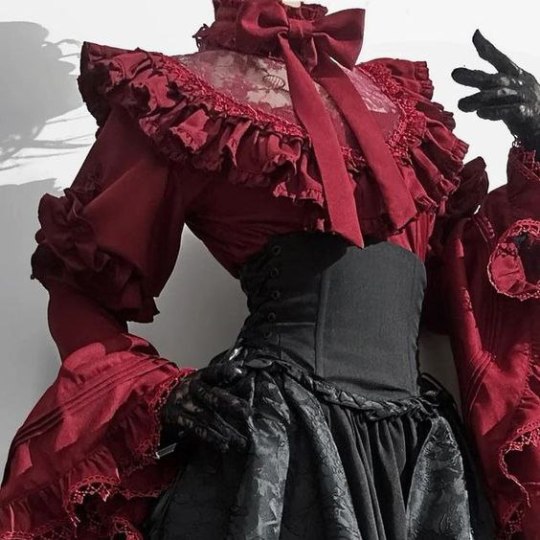
they haven't decided yet if they want to look like a gothic young lord or like a gangster in leather so they just mix it up
music themes



path&type
quantum destruction
lore details
They are from an ocean world, the water is everywhere but it's impossible to drink it due to the salt. The climate change also made the weather unusually hot
People on their planet can manipulate their blood flow to a certain degree
Rea's abilities were always extraordinary compared to his kind but after genetic modifications they became truly unique. Also deadly :)
They're a living voodoo doll, as long as they have at least a drop of someone's blood, they can transfer their wounds (even tge fatal ones) to this person (they can also transfer this person's wounds to themselves but they rarely do it)
Genetic modifications weren't consensual btw. They were done by a group of ipc researchers and then original goal of the project was harmless. But then the lead researcher was changed to Dottore wannabe and the gory nightmare began
The IPC didn't know about it and never checked on the project much. When Rea eventually killed everyone and run away, the truth came up, and the IPC realized how badly they've fucked up. In order to save some face, they've severely downplayed the issue, put all the blame on the research team and publicly apologized for allowing this tragedy to happen
Oh and they've announced Rea dead too. So now catching them is their priority since they're trying so hard to erase their connection to the IPC
Like it's a huuuuge secret that they are directly connected to the ipc
Rea themselves became an intergalactic terrorist with only one goal: to creat as many troubles for the ipc as possible. In fact, the first time they met Aven (the first time they remember at least), they've set up his deal.
The only thing keeping them going was hatred, to the point where they've mindset was practically "as long as I can keep destroying things I hate, I'm alive. As long as I'm able to feel hatred, I exist".
At one point Nanook has turned their gaze on them. Later, when they've joined the Stellaron hunters, Elio reveals to them that their destiny was to became an emanator of destruction. They were lowkey upset they ended up settling for the Stellaron hunters instead lol
They have very shitty memory. Part of this is a trauma response but there's also the fact that they constantly shoot themselves in the head to transfer the injury to their opponent. They regenerate immediately (an important note, they would only regenerate if their voodoo doll mode is activated) but their brain still gets damaged to a degree.
personality
They're immature in a lot of ways. While certainly smart and creative, they're impatient, whiny, a bit of an airhead. They appear bubbly and playful at the first sight, can easily hide their unstable physiological state. May appear nihilistic since they trust Elio so blindly.
Lowkey very attached to the Stellaron hunters but they don't like to admit it. A type of person who would be mistyped as ENTP due to their vibes.
VERY THEATRICAL also prone to escapism.
17 notes
·
View notes
Text
My opinion of The Crow 2024 trailer
Try to keep in mind this is an opinion of the trailer, not the full movie. I have only seen the trailer.
First... Bill Skarsgard is an excellent character actor and he has the potential to be an icon of horror or even a horror sex symbol consider how attractive he is to a lot of people.
The visuals in the trailer are interesting but I do have some qualms about the choice of his haircut. And though I know it is accurate to the character and story, because of how Brandon Lee died, I feel strangely uncomfortable every time he's shot up in the trailer. I also noticed they changed how and why Eric and Shelley were originally murdered.
I was only twelve when the original movie came out and don't remember the graphic novel very well other than that the movie deviated a lot. I remember The Crow story with the pregnant woman (Iris Shaw) better than I remember Eric's story. So I don't really remember how he and Shelley died in the original comic.
There was also a Gangster undercurrent to The Crow but it seems the trailer over-plays that part and downplays the Goth / Gothic trappings.
I kind of hate the song they chose for the trailer and I was going to keep quiet about it but then I saw a lot of other people hated the song too.
The most annoying part is at the end of the trailer with the song, the autotuned "I'm never gonna be alone." with that extra reverb. It's irritating. It's almost deliberately un-Goth / Un-Gothic. Someone suggested it might be to deliberately antagonize the established audience of 90s Goths with bait.
The song is a collaboration between Ozzy Osborne and Post Malone and I have to admit I mostly dislike the Post Malone parts but I was never a big Ozzy fan either. I don't hate the guy. I just don't love him. He's also more metal than Goth or Gothic. I like power metal but something about this rubbed me the wrong way. Oh, well.
youtube
2 notes
·
View notes
Text
'In 2018, an interview with Oppenheimer director Christopher Nolan went viral — possibly because it was the first time he’d ever appeared relatable. In that conversation, he said his children sometimes jokingly call him Reynolds Woodcock, after the aloof, reserved protagonist of Paul Thomas Anderson’s Phantom Thread. Though Nolan’s scripts often feature signature, repeated (and often mocked) tropes, including time manipulation, dead spouses, and protagonists who face complex moral decisions, he injects very little of his own personality into his movies. Characters like Leonardo DiCaprio’s troubled team leader in Inception and Robert Pattinson’s equally troubled handler in Tenet are clearly styled after Nolan himself. But viewers rarely come away from Nolan movies with a greater understanding of his worldview, at least compared to the way directors like Martin Scorsese or Quentin Tarantino put their personalities on screen in every movie they make.
One underappreciated idea does recur over and over in Nolan’s work, though, and it surfaces again in Oppenheimer. The protagonists of many Nolan films become obsessed with a specific fear and go to great lengths to better understand or control their terror. In Nolan’s first blockbuster, Batman Begins, gangster Carmine Falcone (Tom Wilkinson) tells Bruce Wayne (Christian Bale), “You always fear what you don’t understand.” The quote acts as something of a guiding light not just for Bruce, but for Nolan’s back shelf of protagonists who seek a deeper knowledge of their phobias for the sake of control. In Oppenheimer, Nolan imprints this narrative device on a historical figure for the first time, and it feels like he’s being more open than ever about revealing what keeps him up at night.
There is no evidence that J. Robert Oppenheimer, the father of the atomic bomb, struggled with frightening visions of high-energy subatomic particles. This doesn’t come through in any documents about Oppenheimer the man, and Nolan seems to have added the idea to dramatize the film, as Oppenheimer periodically pauses to register and recoil from flashes of light, particles, and fire, all representing wordless fears he can’t explain. Though the movie’s dialogue never explicitly references these mysterious events, Nolan’s evocative imagery asks the audience to fill in the gaps themselves — are we seeing what’s in his mind, his future, or something else entirely?
Nolan’s Oppenheimer presents as an awkward, unsociable student with something off about him. It isn’t hard to imagine that he’s troubled by something. And what does this frightful student do? He dives deep into particle physics, devoting his life to understanding and attempting to control his fear — until it reaches critical mass.
The origin story in Batman Begins is the clearest example of this phenomenon: Batman’s vigilante persona was inspired by a traumatic childhood experience with bats. That plot point hews closely to Frank Miller and David Mazzucchelli’s classic 1987 comic arc Batman: Year One, but the film dives far deeper into Bruce’s fervent need to understand and control his terror. In a number of sequences featuring fear gas used by the movie’s villain, Scarecrow (played by Cillian Murphy, who also plays Nolan’s Oppenheimer), the filmmaker dips his toes into horror-inflected imagery. The Gothic architecture of Gotham combines with nightmarish sequences where villains see the superhero as a demonic monster, literalizing the metaphor of Bruce becoming his fear.
Following Batman Begins, Nolan’s Batman movies continue to dwell on this theme. Nolan assaults his protagonist with a series of villains who take on the shape of new nightmares. It’s as if he’s trying to teach Batman how to overcome the things he most dreads.
In addition to Bruce Wayne, the two protagonists Oppenheimer most resembles in this way are Leonardo DiCaprio’s Dom Cobb in Inception and Guy Pearce’s Leonard Shelby in Memento. The latter, Nolan’s mainstream breakthrough, focuses on a man with short-term memory loss who is so afraid of forgetting his purpose that he has it tattooed on his body. A significant portion of Inception takes place within Cobb’s dreams, which, through a very thinly veiled metaphor, are haunted by his wife Mal, played by Marion Cotillard. Guilt-ridden by the circumstances of her death, he subconsciously creates a murderous avatar in the shape of the shame he’s too afraid to face. He wrestles for control within his memory, attempting to hide her in a symbolic (and literal) basement in his mind. It doesn’t exactly work out.
Throughout Oppenheimer’s three-hour run time, Cillian Murphy’s protagonist struggles with existential horrors that are much larger than his personal regrets. In addition to the frightening visual bursts of atomic space, the film focuses most of its second-act tensions on the threat that the first atomic bomb test might ignite the hydrogen in Earth’s atmosphere. In real life, that threat was discussed and dismissed by the physicists at Los Alamos. But Nolan lingers on it, sending Oppenheimer to get the opinion of Albert Einstein, who acts as a sort of patron saint of science in the film. But Einstein provides no comforting answers, which ratchets up the tension and fear felt by characters and audience alike.
The threat of humans bringing about their own extinction is no new ground for Nolan’s films. And that may answer why, exactly, he’s so obsessed with fear and the war for control. In Interstellar, climate change devastates crops with a futuristic, dystopian blight. In his 2020 movie Tenet, an unseen society in the future attempts to reverse the flow of time to stop climate change before it gets out of hand. Between those two movies lies the World War II film Dunkirk, about the struggle for survival against a faceless threat. Though the Nazi presence implicitly hangs over the movie, Dunkirk doesn’t linger on a potential apocalypse in quite the same way as other Nolan movies. But the pervasive dread remains.
The fearsome final minutes of Oppenheimer drive this point home, as Nolan gives his protagonist a vision of a future devastated by nuclear apocalypse. His visions of dancing particles and flames give way to a clear, unambiguous doomsday — an uncountable number of rockets fire from an unknown country, streaking across the globe and detonating. Fire consumes everything.
Nolan’s devotion to the theme of people wrestling with their fears ties him to his protagonists, and his more recent focus specifically on humanity causing its own doom ramps that fear up to a universal level. It’s a heavy, existential worry, but it’s an illuminating glimpse into the mind of an artist who rarely lets the audience in. In his films, when a character obsesses about a topic, it typically means that’s the fear that keeps them up at night and drives them toward obsession as a means of control. Both Nolan and his iteration of J. Robert Oppenheimer are exposing their fears that humanity has the power to devastate life on Earth. And as climate change and political tensions simultaneously rise across the planet, it’s hard to blame him.'
#Christopher Nolan#Oppenheimer#Leonardo DiCaprio#Robert Pattinson#Paul Thomas Anderson#Phantom Thread#Tenet#Inception#Martin Scorses#Quentin Tarantino#Batman Begins#Tom Wilkinson#Christian Bale#Guy Pearce#Memento#Marion Cotillard#Albert Einstein#Los Alamos#Interstellar#Dunkirk
3 notes
·
View notes
Text
Review: Wild at Heart (1990)
Wild at Heart (1990)
Rated R

<Originally posted at https://kevinsreviewcatalogue.blogspot.com/2023/05/review-wild-at-heart-1990.html>
Score: 5 out of 5
Wild at Heart is a quintessential David Lynch movie, a film that's not as weird as his reputation suggests but gets treated as such anyway (including by Popcorn Frights, who hosted a screening this past Friday night) because he often uses a lot of stylish camera tricks and goes for a very offbeat tone. The "non-linear storytelling" is really just a very liberal use of flashbacks, and beneath the stylization, the story is very coherent, even if it doesn't hit the beats you'd normally expect. What it is, rather, is a film that carries the substance one would normally expect from Lynch, a melancholy exploration of Americana as our protagonists take a long road trip across the South that evokes a dark subversion of The Wizard of Oz. It's the kind of movie where you can immediately understand why a musician like Lana Del Rey seemingly built her entire persona around Lynch's films, as I found myself immediately drawn in by its modern-day Southern gothic atmosphere, its captivating lead performances by Nicolas Cage and Laura Dern, and the mounting sense of dread as two seemingly star-crossed lovers take a long road trip and encounter a number of increasingly weird characters along the way. I've heard that it's divisive, regarded as either one of Lynch's best films or one of his worst with not a whole lot of middle ground between them, but as somebody for whom this was his introduction to Lynch's films, I can say that I'm certainly intrigued, and eager to seek out his other movies.
The film opens in Cape Fear, North Carolina with one of our two protagonists, Sailor Ripley, getting targeted for murder by Marietta Fortune, the wealthy, snobbish mother of his girlfriend Lula, only for him to brutally beat the assassin she hired to death in front of a large crowd at a fancy party. Two years later, with Sailor out on parole (the court judged that, while excessive, he was acting in self-defense), he and Lula immediately hook up again, much to the horror of her mother, who sees him as a sleazeball who's corrupting her daughter (and also wanted him for herself). Thus begins a long road trip as Sailor and Lula drive west in a vintage Ford Thunderbird, breaking parole, while unbeknownst to them, Marietta hires the private detective (and her on-and-off boyfriend) Johnny Farragut to retrieve Lula -- and also hires the vicious gangster Marcello Santos to outright kill Sailor.
The plot of the film is largely in Marietta's side of the story, but the actual meat of the film concerns Sailor and Lula, a pair of young lovebirds on the run. Everybody involved with the film has described them as two halves of one character, and that is how they function, a young couple deeply in love who won't let the disapproval of Lula's mother get in the way of that love. While Nicolas Cage does get one of his famous freakouts at the start of the film, for most of it he's channeling Elvis Presley and James Dean, and not just because he's in a T-Bird and sings the King's romantic songs to Lula; from his accent to his snakeskin jacket, he projects an image of '50s cool that even the film itself admits is kind of a put-on, but it's one that he makes work. Laura Dern, meanwhile, was both beautiful and challenging as Lula, the rebellious daughter of an aristocratic Southern belle who's seen up-close the hypocrisy and hidden horrors of her upbringing that you're not supposed to talk about in polite company. And together, I fully bought their love story. Not only was it hot as hell (fair warning: there's a lot of sex in this movie), the two characters at the center were compelling thanks to Cage and Dern's performances, such that I wanted to see them together and quickly came to despise Willem Dafoe's character in his brief but instantly despicable role. In real life, you know that a relationship like theirs shouldn't work, but on the screen here, it did anyway. The ending of this film was a difficult one that could've easily turned corny, but it felt earned.
The supporting characters, too, were outstanding and prevented the film from just becoming a meandering mess, the big one being Diane Ladd as Lula's mother Marietta. We're shown early on that Marietta wanted Sailor for herself, the implication being that she's jealous of her daughter's relationship with him and has decided that, if she can't have him, no one can. Further revelations of her past with Sailor only drive home just how disturbed she actually is, especially her history with J. E. Freeman's Santos and Harry Dean Stanton's Farragut, the men she sends after Sailor and Lula, and how Sailor's life intersected with hers in the past. Willem Dafoe, meanwhile, is only in the film briefly, but his character Bobby Peru immediately steals the show once Sailor and Lula meet him in a small town in Texas, an absolute scumbag of a criminal whose entire time on screen is spent doing, planning for, or implying terrible things. The whole movie is filled with the kinds of little characters who you might encounter in these kinds of small towns, as well as minor figures in the characters' lives, played by a host of character actors like Crispin Glover, Sherilyn Fenn, and Isabella Rossellini. "It's about the journey, not the destination" is a cliché, but it absolutely applies here: I felt like I was on a road trip with Sailor and Lula as they journeyed across America, blissfully unaware of Marietta's goons coming for them.
Lynch, for his part, does a great job of capturing that dreamlike feel on the screen. His American South is a land of lonely roads, rock music, and interesting sights that you might not experience anywhere else. The brief plot detour involving the people who crashed on the side of the highway, for instance, may not have had any real plot purpose, but it did a lot of work building up that sense of dread as you began to suspect that Sailor and Lula's journey was not going to end well for them. It was stylish without feeling stylized, a film that made great use of the rural South from the forests back east to the dust of West Texas, and it got me in the feeling of taking a long journey to nowhere in particular, reminding me of some of the sights I saw last year driving from Florida to Utah.
The Bottom Line
It's a hard movie to describe, and it's not for everyone, but I absolutely adored Wild at Heart. I'm now eager to seek out the rest of David Lynch's filmography thanks to this beautiful, captivating dark romance, a film where even the few flaws I could come up with felt like they were put in there for deliberate effect. Check it out.
#wild at heart#1990#crime movies#crime#thriller#romance#road movie#david lynch#nicolas cage#laura dern#willem dafoe#crispin glover#isabella rossellini#diane ladd#harry dean stanton
2 notes
·
View notes
Text
319 of 2022
I was born in…
1985
1986
1987
1988
1989
1990
1991
1992
1993
Later
I am…
Under 5ft
5ft - 5ft 3
5ft 3 – 5ft 5
5ft 6 – 5ft 8
5ft 9 – 5 ft 11
Taller than 6ft
My body type is…
Petite
Slim/skinny
Athletic
Average
Curvaceous
Just Right
Full
Big & Beautiful
My eye color is…
Blue
Green
Gray
Hazel
Brown
My hair is…
Blonde
Dark Blonde
Strawberry Blonde
Ginger/red
Brown
Dark brown
Black
Color not mentioned
High-lighted
Dyed
Natural
Wavy
Curly
Straight
Short
Medium length
Long
I would consider myself…
Shy
Outgoing
Sociable
Anti-social
Sensitive
Insensitive
Bitchy
Kind
Friendly
Aloof
Mean
Intimidating
Approachable
Confident
Quiet
Loud
Popular
Different
Alone
Artistic
Creative
Smart
Musical
Loved
Hyperactive
Lethargic
Rebellious
Scary
Silly
Funny
Fun
Polite
Rude
Outspoken
Honest
Gullible
Miserable
Selfish
Happy
Depressed
Desperate
Lonely
Ambitious
Nonchalant
Affectionate
Romantic
Loving
Generous
In my spare time I like to…
Use the internet
Use myspace/facebook etc
Talk on msn/aim
Draw
Paint
Photoshop
Be artistic in other ways
Write poetry
Write stories
Write blogs/journals/diaries
Hang out with friends/boyfriend/family
Go out to eat
Play sports
Play an instrument
Sing
Church
Read
Walk
Play with pets
Walk pets
Surveys
Camera whore
Dance
Drink
Smoke
Hug/cuddle
Ice skate
Rollerblade (rollerskate)
Shop
Watch TV
Watch movies at home
Go to the cinema
Go to the beach
Sunbathe
Go to the gym/exercise
Photography
Drive
Sleep
Relax
In school my favorite subjects were/are…
English language
English literature
Languages
Social Studies
Business Studies
Maths
Biology
Chemistry
PE
History
Geography
Religious Education
Art
Graphic Design
Technology
Cookery/Home Ec
Music
I have these pets…
Dog
Cat // x2
Hamster
Rat
Mouse
Chinchilla
Fish
Tortoise
Rabbit
Guinea Pig
Snake
Spider
Other insect
Bird/budgie
My favorite colors are…
Black
White
Red
Green
Blue
Yellow
Pink
Purple
Orange
Brown
Maroon
Beige
Gray
I listen to this music…
Pop
Synthpop
80s
R’n’B
Rap
Hip Hop
Blues
Reggae
Jazz
Emo
Screamo
Hardcore
Punk
Goth
Metal
Rock
Rock’n’Roll
Electronica
Techno
Dance
House
Garage
Country
My style is…
Original/unique
Modern fashion
Casual
Sporty/Athletic
Emo
Scene
Punk
Goth/Gothic
Slutty
Gangsta
Skater
Hippie
Smart
Prep
Chav
Geeky
Not listed here
I love to wear…
Long dresses
Short dresses
Long skirts
Short skirts
Jeans
Hoodies
Cardigans
Sweaters/jumpers
Long-sleeved tops
Short sleeved tops
Sleeveless tops
Vest tops
Halter neck tops
Colorful clothing
Darker clothing
Stripes
Polka dots
Velvet
Corsets
Bodices
Jackets
Coats
Frills and lace
Revealing clothing
Cleavage enhancing tops
See-through clothing
Push up bras
Balcony bras
Normal bras
Sports bras
Padded bras
Thongs
French knickers
Normal underwear
Granny pants
I watch these kind of movies… (I don’t like movies, so no choice)
Action
Adventure
Black & White
Family/kid
Disney
Thriller
Tragedy
Horror
Psychological
Drama
Historical
Documentary
Fantasy
Science Fiction
Comedy
RomCom
Musical
Adult/Porn
Animation
Christmas
Silent
War
Western
Crime
True life
My ideal guy/girl would be/have… (I don’t have a type, I just like guys, preferably those who have something special about them, so no choice here)
Tall
Medium Height
Short
Blonde
Brunette
Red-haired
Blue eyes
Brown eyes
Green eyes
Hazel eyes
Good looking
Average looking
Facial hair
Long hair
Short hair
Medium length hair
Afro
Dreadlocks
Tanned
Pale
Thin
Medium build
Muscular
Bigger build
Athletic
Alternative
Emo
Goth
Prep
Casual/own style
Punk
Gangster
Scene
Surfer
Skater
Popular
Sociable
Outgoing
Not so outgoing
Quiet
Shy
Loud
Witty
Intelligent
Musical
Artistic
Sporty
Polite
Kind
Friendly
Affectionate
Romantic
Traditional/old-fashioned
Cool
Geeky
Different
Rebellious
Masculine
I like to eat…
Italian
Chinese
Indian
Mexican
Other
Vegetarian diet
Vegan diet
Meat
Fish // sometimes only
Vegetables
Fruit
Cheese
Yogurt
Pasta
Pizza
Rice
Tacos
Curry
Burger
Chips/fries
Crisps
Biscuits/cookies
Chocolate
Sweets
Ice cream
Bread
Cake
Cereal
Toast
Sandwiches
I like to drink…
Water
Tea
Coffee
Hot chocolate
Orange juice
Apple juice
Other juice
Milk
Iced tea
Milkshake
Coke
Pepsi
Sprite
Diet
Dr Pepper
Alcohol
I am scared of…
Heights
Closed spaces
Open spaces
People
Serial killers
Rapists
Rodents
Spiders/other insects
Illness/disease
Death
Losing loved ones
Fire
Water
Some animals
Getting lost
Rejection
Heartbreak
Commitment
Failure
The future
The past
Sex
Heaven/hell/afterlife
Loneliness
Violence
Relationships
Needles
Being fired
Doctors
Surgery
Dentists
Fish
Squids
Sharks
Blood
Depression
This survey…
Was great, I really enjoyed it
Good
Okay
Passed the time
Wasted my time
Whatever
1 note
·
View note
Text
Story Scrap: From Monochrome to Vibrancy
This is a story scrap I actually DID start writing way back when I was in high school. The story’s a bit different than what I had for the original idea though. It’s still unfinished but the chapters are still up on Wattpad. Maybe one day I’ll post them here with some commentary for posterity and self-reflection
A girl lives a normal and bland life. In terms of her own traits, she is ridiculously average. She was so bland that she just faded into the background. She didn't have any friends as those who tried to get close to her soon got bored and forgot about her. Despite her smiling mask, she was saddened by this, and the day her 8th grade year ended, she wished on a star to have an exciting life with friends. She spends alone for the most part until her freshman year starts. Upon getting to school she is surprised by a series of odd characters that have joined the 9th grade class, and they all seem to set their sights on her. All throughout the year, she is taken on an adventure by one of her classmates, becoming closer to them and discovering her skill for drawing and writing stories as she records each adventure.
At the end of the year however, they reveal themselves as products of her wish and say goodbye to her as she will no longer need them. There are tears, but as she begs them not to leave, they fade into stardust. She spends another summer alone and when she goes back to school the next year, each of the now missing students are replaced by new kids who claim to have been there last year and nobody remembers the old kids. The girl is deeply saddened by this and draws and writes stories about her old friends to cope. The other student see her works and are impressed. She begins to make new friends and is known as a wacky, imaginative, and cheerful person.
Special Classmates: Mermaid, Prince from a Fantasy Dimension, Superhero, Alien, Wizard, Time Traveller, a Gangster Kid, a Youkai, an Exorcist, a Ghost, a Vampire, an Android, a Wolf Boy, a Bunny Girl, a Reaper, a Knight, a Ninja, a Famous Singer, Rich Girl in Gothic Lolita, Mori from OHSHC but raised in the Forest
1 note
·
View note
Text
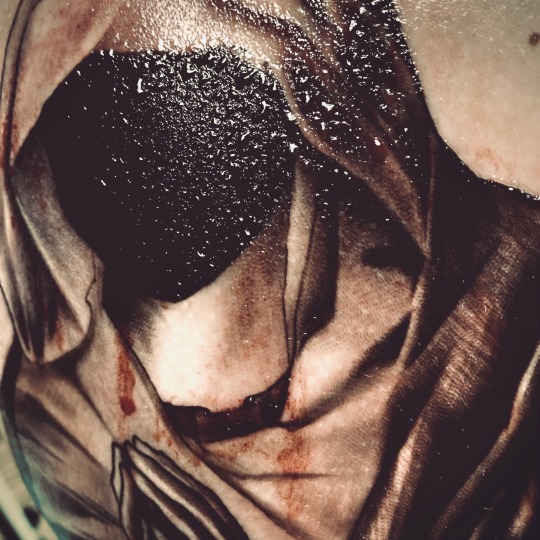
blood is a necessary sacrifice.
#tattoos#aesthetic#original photographers#grunge#gothic#gothcore#hip hop#tattoo#religion#religious#catholic#catholicism#catholic art#abstract#realism#religious aesthetic#religious art#gangster#biblical#light indie#warmth#warm colors#blackwork
20 notes
·
View notes
Text
Review: Cowboy Bebop (Netflix, 2021)

There’s a memorable scene from Cowboy Bebop, the 1998 anime on which Netflix’s new live-action adaptation is based, where series protagonist Spike lays pinned to the floor of a gothic church by Vicious, his former comrade and a symbol of a brutal past he’s been unable to escape, while pointing his gun back at him. A recreation serves as a climactic shot in the new series, a scene where everything should come together, both the attention paid in replicating details from the anime and the new creative direction toward which the team is taking this series. This is where all the work and genius should pay off.
But that’s not what happens. The action moves too quickly. The dialogue is stilted, and revelations blase. The special effects looks amateurish. And as it turns out, this vision of Cowboy Bebop is unable to fundamentally grasp what made the original series so special and, like too many films produced by the movie-a-minute Netflix, is created by a crew that doesn’t have the skill to develop an exceptional series, no matter—and in part because of—how great the source material is.
At first, though, it seems as if the series might just work. The opening scene of Cowboy Bebop (2021), where space cowboys (bounty hunters) Spike and Jet take down a violent crew in an intergalactic casino, begins with a bang, capturing the energy, humor, violence, and fun of the original, providing a semblance of hope for this adaptation and immediately demonstrating how closely the show will try to adhere to the anime. This devotion to the classic has been described as a desire “to stay true to the anime’s spirit.” Indeed, Cowboy Bebop (2021) has invited comparisons through almost every nostalgia-imbued piece of promotional material Netflix has released abd by just how closely it emulates the costumes, art direction, scenes and even entire episodes from its predecessor.
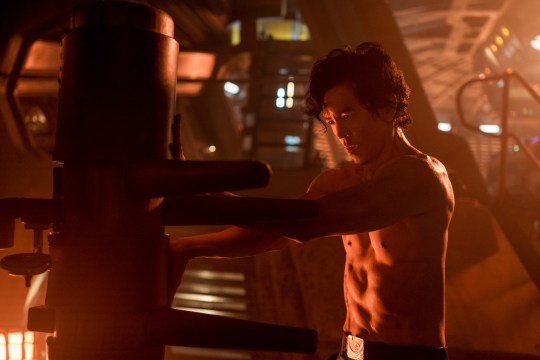
Cowboy Bebop (2021) struggles to use John Cho in a way that shows Spike to be a master of Jeet Kune Do; it relies on faraway and concealed shots in fight scenes, and way more gun play than fistfights. COWBOY BEBOP (L to R) JOHN CHO as SPIKE SPIEGEL in COWBOY BEBOP Cr. KIRSTY GRIFFIN/NETFLIX © 2021
The attention to detail really is off the charts. The Bebop and other ships, as well as the wardrobe for the main cast (though some have and will continue to lament on how anime Faye’s skimpy outfit is covered up in this adaptation and that Vicious is missing the signature crow on his shoulder) is meticulously crafted and modeled often precisely on what was featured in the original. The set pieces and costumes are a sight to behold—when we can see them, that is. Unfortunately, as is also the case with other Netflix series, though most famously in HBO’s final season of Games of Thrones, the dreariness of the scenery makes it difficult to see the backgrounds and design.
Thankfully, Cowboy Bebop (2021) isn’t drawing from a show that relies merely on glitter and shine. Those unfamiliar with the 1998 series will discover that beneath the jazzy and stylish aesthetics, this is a science fiction story with great depth. Spike (John Cho), a lithe, cool practitioner of martial arts with a cloudy criminal past, and his partner, Jet Black (Mustafa Shakir), a former cop who is down on his luck but nonetheless keeps intact a high moral integrity, fly across the solar system tracking bounties, but are also running to and from their own haunted pasts. Neo-noir elements feed into the feel of the series, which dives as much into the world of gangsters (the Syndicate), speakeasy-style nightclubs, and detectives as it does bounty hunters (space cowboys).
While the writers try to build onto this depth by fleshing out the characters’ pasts and adding other original components to the story, they also tend to stick intimately close to the original. Almost every one of the ten episodes has an anime equivalent, and the general flow of the episodes is the same, too. It’s surprising, then, that the show barely includes a most vital component of the 1998 series, one that has fed other science fiction shows with similarly humorous and genre-bending sensibilities, like The X-Files. As in that series, Cowboy Bebop (1998) frequently referenced and celebrated pop culture, with nods to Aliens, The Killer (in the above-referenced church sequence), and 2001: A Space Odyssey, among dozens of other films, movies, songs, and celebrities. But its notable that this element is immediately missing in the remake. Episode one of the Netflix show, which should be a play on Robert Rodriguez’s breakthrough film, Desperado, doesn’t seem to even acknowledge that connection at all. It plays it straight.
A few pop culture references are made in other episodes, but just barely so, as with one to Game of Death that feels more like an allusion to Cowboy Bebop (1998) making an allusion to the Bruce Lee film. It’s the same in Vicious and Spike’s showdown in the cathedral.
It’s stunning, really, to see this aspect absent from the new series, since the winks and nods are an immense portion of the “spirit” of Cowboy Bebop (2021), that which the team has expressed a desire to get right. What results is the opposite, an imitation of the aesthetics of the anime but not of the deeper heart and soul of the original work. It’s almost as if the creative team doesn’t consist of Cowboy Bebop (1998) fans as advertised, of men and women who watched the show countless times over the past two decades, but rather of those who are only passionate about how cool the show looks. There’s a lack of understanding about the property, and apparently no appreciation at all for the 70s, 80s, and 90s movies, shows, and music the anime celebrated.
Rather, Cowboy Bebop (2021) emphasizes a different aspect of the 1998 version—the characters and how they come together as a team and family. While this happens subtly and with intentional discomfort in the 1998 series, it transpires a little too easily here, as when Faye (Daniella Pineda) and Spike forget their past difficulties over a little bit of fishing. If only I could forget how someone aimed a gun at me after some chit-chat about fish and women!
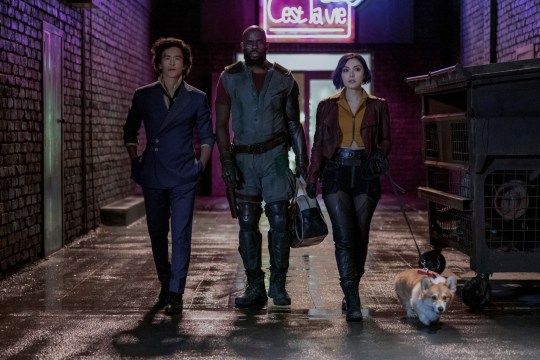
The team’s all here—or is it? My lips are sealed. COWBOY BEBOP (L to R) JOHN CHO as SPIKE SPIEGEL, MUSTAFA SHAKIR as JET BLACK, DANIELLA PINEDA as FAYE VALENTINE and EIN in Cowboy Bebop Cr. GEOFFREY SHORT/NETFLIX © 2021
This gets back to the profound flaw with Cowboy Bebop (2021)—the inferior quality of the scripts. I frequently scratched my head at why certain elements were retained from the anime and others changed. Take “Binary Two-Step,” for instance, the 2021 episode analogous to “Brain Scratch” (1998). Spike is taken in by a cult connected to digital technology. In the anime, this is a clear reference to Heaven’s Gate, but in 2021, the whole episode no longer feels relevant. Why include it when you could have adapted one of more than a dozen other episodes?
Part of the answer is that Cowboy Bebop (2021) is structured in such a way that frames it for a sequel (rarely a good way to develop a series), so the creative team had to pick and choose now, while saving some episodes for later, should a second season be greenlit.
The other is simply that the team adapting this project lacks the skill and vision required to properly do so, to take a sophisticated, thoughtful, and entertaining series and adapt it into the same. It’s almost as if they’re overwhelmed by Shinichiro Watanabe’s vision (“this new genre itself”), and either out of fear or lack of competency, cannot add enough original elements that match the masterful strokes of the anime director. “Binary Two Step” has some fun with a “dream within a dream” type of scenario, for instance, but does relatively little else to set itself apart from its anime counterpart. Why not focus this particular episode instead on a current cultural event, something more relevant? How about weaving a more updated note on the danger of technology into the tapestry of the franchise? Wouldn’t that accomplish the twin goals of creating something new and honoring the original?
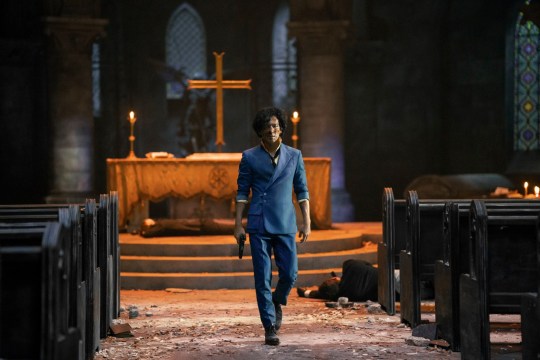
Cowboy Bebop (2021) succeeds in attention to detail, such as in adapting the church scene from “Ballad of Fallen Angels,” but where it lacks in the understanding and conveying the big picture. COWBOY BEPOP (L to R) JOHN CHO as SPIKE SPIEGEL in COWBOY BEBOP Cr. GEOFFREY SHORT/NETFLIX © 2021
It’s a shame, too, because there is strong talent involved here, especially in the cast. It’s a delight to see John Noble and Adrienne Barbeau make notable and significant appearances, while lesser known actors also excel in one or two-episode roles, like Lucy Currey, who plays Judy with energy and attitude, and particularly Lydia Peckham, who brings both an air of maturity and vulnerability to Katerina in episode one.
In the main cast, Mustafa Shakir is a revelation (to me at least—fans of Marvel’s Luke Cage will already be familiar with him). His face, body language, and mannerisms convey better than the writing does that Jet is particularly and perpetually down on his luck, as if the universe is conspiring against him, all while Shakir gives his best vocal impersonation of Beau Billingslea. In a show that is desperate for comparisons to its source material, Shakir’s Jet may be the only improvement on its predecessor.
Meanwhile, Daniella Pineda radiates this big, loud energy through her portrayal of Faye. As John Cho has stated, “Daniella is just like Faye,” and I believe it—she emotes a believability in expressing every line with misplaced confidence that is just like her anime counterpart, and at times reveals a vulnerability as well, this despite a script that contains some insanely bad pieces of discourse (which she totally sells, by the way).

The show conveyed Faye’s innocence in a strange way rather than by the more age-focused concept from the series, but Pineda is so good that I had little complaint. COWBOY BEBOP (L to R) DANIELLA PINEDA as FAYE VALENTINE in COWBOY BEBOP Cr. GEOFFREY SHORT/NETFLIX © 2021
Thankfully for Pineda, though, she escapes most of the worst dialogue, reserved for scenes involving the love triangle between Spike, Vicious (Alex Hassell), and Julia (Elena Satine), the ingénue who comes between the former “brothers.” As the series drifts into neo-noir mode, you’ll hear classic lines like, “I have traveled across the entire solar system and never found anyone that makes me feel the way that you do.” I half expected that to be followed up with grievances about sand getting everywhere or Julia screaming, “Vicious, you’re breaking my heart!”
But I’d rather do with cringe-worthy romance than the hours of stale Syndicate world-building and Vicious’ associated origin story. Cowboy Bebop (2021) does a far deeper dive into Spike and Vicious’ past than its predecessor. The choice to lay everything bare could have been a good one, but because the scenario-building is rote (there is nothing new under the sun in the show’s extensive flashbacks), Spike comes out flat, doing John Cho no favors as he tries to inhabit a character Netflix describes as “impossibly cool,” one who should exhibit the cool and grittiness of a film noir protagonist and the modern pizazz of a vulnerable action hero, but instead falls somewhere below on both counts.
But it’s not just Spike who is dulled down—it’s the entire Syndicate in which he was and Vicious remains a part. Mostly gone are the triad and yakuza structure of this gang, except through superficial flourishes, replaced by a less interesting and oft-repeated mafia dynamic and structure. Vicious is presented as living and growing in this culture, motivated by jealousy and daddy issues. It’s unimpressive and all very soporific. And that might be the greatest sin of all in Netflix’s Cowboy Bebop adaptation: It’s boring.
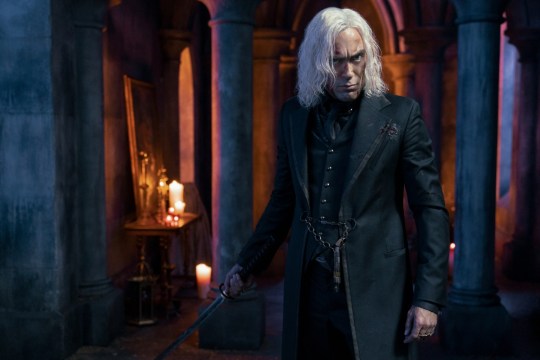
The thin, strangly Vicious hair looks awful and ridiculous on Alex Hassel’s cleft-chinned, tall features. COWBOY BEBOP (L to R) ALEX HASSELL as VICIOUS of COWBOY BEBOP Cr. GEOFFREY SHORT/NETFLIX © 2021
Actually, check that. There’s a worse sin, and that’s Spike’s “real name,” Fearless. Yep, that’s what they call him all throughout the series, without as much as a smirk. Fearless. What a blunder, and what a precise example of how impossibly uncool the newly developed material is.
It’s this twin dynamic of poor writing and uninspired world-building that adds tedium to what should be an exciting tale. Each layer or characterization is worse than the last. I’ve barely even mentioned Julia. She’s presented as an abuse victim, a plot device that feels too commonplace, out of a made-for-TV movie, and almost offensive to the character.
That said, Cowboy Bebop aficionados and others may want to tune in simply to see the occasional sequences which are well-constructed. I was particularly thrilled with one featuring Vicious and reminiscent of the “Showdown at the House of Blue Leaves” in Kill Bill. And the “Ballad of Fallen Angels” church scene also looks magnificent, even if the action falls a little flat.
The clarity of vision in some of these scenes makes me wonder how so many other components were missed. The writing feels like a first draft, and the final editing as if it wasn’t complete, with too little time spent on important details, like those that establish setting, for instance, which were at best indistinguishable (I frequently wondered what planet we were on)
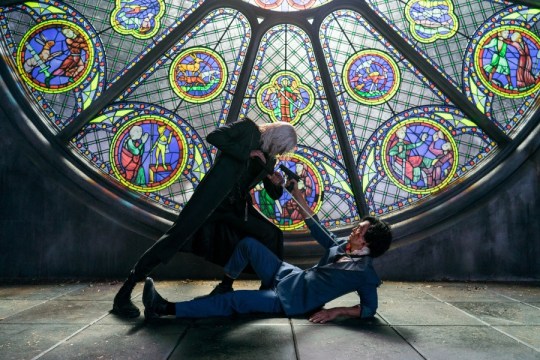
This is another well-choreographed and splendidly shot scene, but suffers from novice SFX and writing seemingly inspired by Solo: A Star Wars Story. COWBOY BEBOP (L to R) ALEX HASSELL as VICIOUS and JOHN CHO as SPIKE SPIEGEL of COWBOY BEBOP Cr. GEOFFREY SHORT/NETFLIX © 2021
The soundtrack, at least, not only remains intact, but is carried further by a substantial amount of original material composed by Yoko Kanno, who brilliantly composed the original music and reunited with her band, the Seatbelts, for the new score. Her work adds a sense of familiarity that at first is much welcomed, before it, too, feels like a superficial attempt to divert attention from the serious flaws in the series by cashing in on the original.
That assessment is a little harsh, but the the truth is harsher still, that perhaps the intentions were noble, but the follow-through mediocre. To use the casino setting from the first scene of the show as an analogy—Netflix is a high roller, but without enough skill to beat the house.
To use another one, Netflix’s Cowboy Bebop is not at all like it’s two leads. Despite how skilled and physical Spike and Jet are, they rarely get their man; they struggle, fight, and put their lives on the line, but the hunt very seldom goes as planned. On the occasion that things do work out, it’s because of their expertise, strength, determination, trust, and gumption. They earn every woolong they’re rewarded.
Netflix was rewarded not through any of such characteristics, but by the size of its pocketbook. It may have purchased the rights to adapt Cowboy Bebop, but it didn’t earn those rights by pulling together a team on equal footing to do the work, resulting in the latest, if not most egregious, example of a poorly adapted anime property.
But just like Faye is Faye, Vicious is Vicious, and Jet is Jet, Netflix is Netflix, and an inconsistent, fatuous, and forgettable final product is what we’ve now come to expect from them.
After all, it’s as they say (and can’t you just imagine Shinichiro Watanabe, who has distanced himself from the new series, speaking this very line?)—easy come, easy go.
=====
Cowboy Bebop (2021) premieres on Netflix this Friday, November 19th.
Read more of our anime analysis and other content by subscribing to our weekly newsletter. And be sure to return to the blog on Wednesday, when we post a first impressions piece over episode one of Cowboy Bebop (2021), a collaborative article by a number of our writers developed after each watched only the first episode.
Featured image: COWBOY BEBOP (L to R) ALEX HASSELL as VICIOUS and JOHN CHO as SPIKE SPIEGEL of COWBOY BEBOP Cr. GEOFFREY SHORT/NETFLIX © 2021
#Live Action#Reviews#Cowboy Bebop#Cowboy Bebop 2021#Netflix#Live Action Reviews#Anime#Articles#Author: TWWK
3 notes
·
View notes
Text

Alistair ref sheet by @iravaid
Probably the character of whom I'm most proud, and who's come the furthest since their ideation. Alistair was originally... almost a joke, riffing off the templates in the early Clanbooks that were really obvious expies (Giovanni Lara Croft springs to mind). Hence, Vampire Malcolm Tucker - a foul-mouthed, scheming fixer with no official power in the Camarilla but a terrifying personality and an understanding that he was there to do the dirty work. Then I actually started playing the old fart, and worked out a whole CV for him, and between his being a coterie Retainer in Blood Money (my sadly abortive 1960s Dunsirn game) and a coterie Mawla in Wild Roses, he started to get... depths.
His gangster past developed out of my deep and slightly embarrassing love of Guy Ritchie movies - look, VtM is a Mafia thriller with fangs, it owes as much to the gangster genre as the gothic mode, and Snatch came out when I was a teenager, it's just... one of those synchronicities. There's something about the grotty, chippy, top-bants-with-the-lads energy of those films that I think works for a peculiarly British kind of vampirism, especially for an Anarch game that's opposed to the higher, cleaner, classier grace-and-favours qualities of the Camarilla. And of course, the violent farce plot structure works so well for a TTRPG, which is after all a Disgraceful Behaviour Simulator anyway.
Historically speaking, Alistair occupies a kind of Arthur Thompson shaped space in Glasgow's underworld (one might, if inclined to really force the historical point, suggest that in-WoD, he successfully assassinated Thompson in 1966, becoming the connected and feared three-dots-in-Retainers ghoul he needed to be for the start of Blood Money proper in 1969).
I can talk about this old man... a lot. He's enormous fun to play - abrasive, charming, absolutely unafraid of Kindred ten times his age. They've been around longer than him but he's older than them, he's lived a full life and has none of the insecurities an eternal twentysomething is stuck with. Also, that one dot in Composure giving rise to furious swearing fits in moments of crisis always puts a smile on my face.
#oc: alistair dunsirn#chronicle: wild roses#chronicle: blood money#vtm oc#vampire oc#vampire the masquerade#vtm#dunsirn#hecata#clan giovanni#clan hecata
11 notes
·
View notes
Text
12 Favorite Superhero movies
So there is this weird backlash to superheroes ,that I dont get.That could be because I love superheroes and as such wanted to highlight some of my favorite Superhero movies
1.Superman The Movie and Superman II
These movies were the first attempt to approach a comic book relatively seriously ,though still maintaining a sense of humor .I kind of view them as one big movie,the first half being the orgin story and setting up the key characters,while the second half explores them .and places a great threat against them in the form of the Kryptonian Criminals .I flip flop on which one I prefer,as Superman the Movie is more solid but Superman II is more fun,and overall I love both movies so why not give them the same spot .The cast is pretty spot on ,the villains are great in both films ,they tell the tale of Superman well and capture the wonder and whimsy I associate with him

2.Batman
When I was a kid the Batman movies were the definitive superhero movies,and while I personally love Batman returns,the best of them has to be the original Batman .While it’s not the best adaptation of Batman as it changes a lot (Batman kills,Batman and Joker are connected, we know Jokers backstory,etc )I think what Tim Burton captures is the feel of Batman ,with the gothic atmosphere of Gotham ,and the brooding Batman in conflict with the loud and colorful Joker .Apart from the aesthetics and Danny Elfmans score,Jack Nicholsons take on the Joker is really the highlight

3.The Captain America Trilogy
I love all three films in the trilogy ,I couldnt pick one.The First Avenger is a great tribute to the Golden age of comics ,Winter Soldier is a spy thriller that explores interesting ideas and Civil War sets our heroes against eachother ,for both political and personal reasons .I like all three for diffrent reasons,but I think it is just a very solid trilogy with my favorite character in the MCU
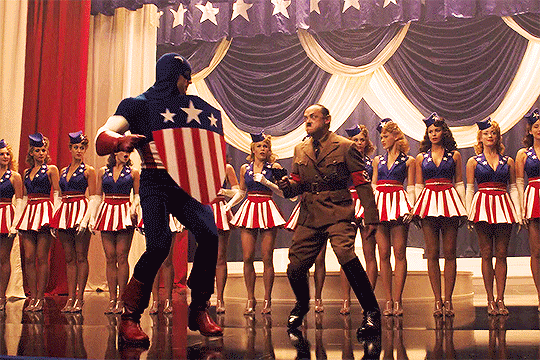
4.Wonder Woman
So I love a good super hero period piece .I saw this film when I was having a real bad day ,and It brightened my day .Diana is such a hopeful character ,and setting her against the gloomy backdrop of WWI was brillaint.The supporting cast is fun ,Wonder Woman herself is a great lead and the battle in No Mans Land is fantastic
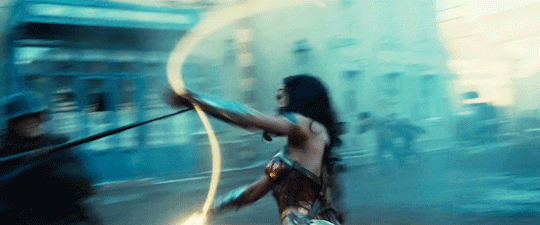
5.The Crow
My favorit movie based on a comic book .A story of grief and revenge. It is darker then most superhero fare that you kind of forget it is one ,heck I have seen people argue its more of a horror film ,but I’d say it’s a gothic superhero film,with our undead hero returning from the grave to take vengence on the criminals responsible for his and his fiance’s death.We have a costumed hero,a rather theatrical supervillain in the form of the crimelord Top Dollar ,and elements of the supernatural.This film is just cool,the soundtrack,the look,the action,the hero and villain are just so cool to me
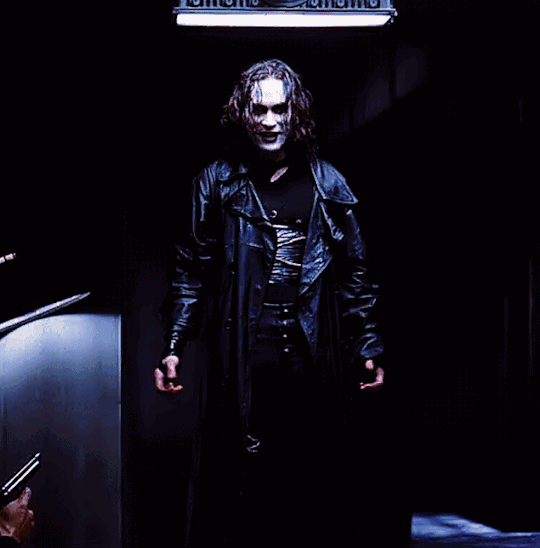
6.The Mask of Zorro
Film was cool when I was young but even cooler now that I am older.It is the tale of Zorro having escaped prision training a successor,it’s basically Batman Beyond BEFORE Batman Beyond.It has AMAZING fight scenes ,the romance is amazing ,it’s really funny ,and it’s just a cool update of Zorro
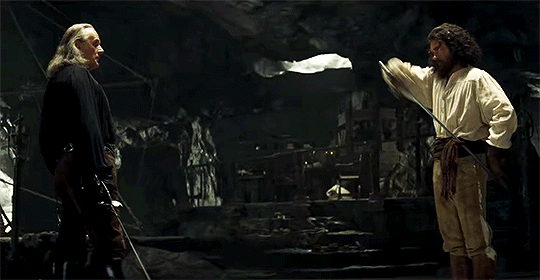
7.Logan
Hugh Jackman had an interesting 17 year journey as Wolverine and goes out with a hell of a bang .It’s almost a western,with Logan and Professor X having to go on a journey with this mysterious child.This is a brutal film,in terms of both violence and emotions,with fantastic performances by Hugh Jackman,Patrick Stewart ,Daphnee Keen and Stephen Merchant ,a pretty good villain in the form of Boyd Holbrook as Donald Pierce and is a good finale for the Wolverine character

8.Spider-man Into the Spider-verse
The best Spider-man movie .It focuses on Miles Morales,as he must take up the mantle of Spider-man ,learn to control his powers, help Spider-people from other dimensions go back home and save reality from the Kingpin .The animation is gorgeous ,the story is great,the characters are fun (Especially Nicholas Cage as Spider-Man Noir ) and it is very emotional
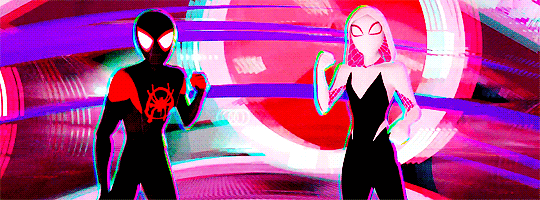
9.Batman the Movie
I LOVE THIS MOVIE .It is legit one of my favorite Batman movies,and a solid Silver Age romp with Batman and Robin fighting against their four arch enemies :Penguin,Catwoman,Riddler and Joker .We get a romance between Bruce Wayne and Catwoman that is oddly sad ,Penguin is the big bad (Which is refreshing cause normally Joker would take that role ),and a lot of funny moments including the immortal”Some days you just cant get rid of a bomb”
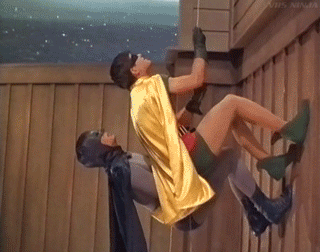
10.Avengers Infinity War and Avengers Endgame
The two part epic is a finale of sorts for the MCU ,at least of the Avengers saga which started with Iron Man.We have an intriguing villain in the form of the Mad Titan, Thanos,great action,heartbreak ,and just a grand scale ,these movies feel BIG
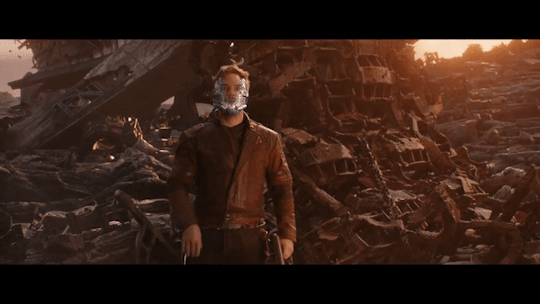
11.Batman Mask of the Phantasm
Probabbly my favorite Batman movie,that is both a mystery with a mysterious killer targeting gangsters and a peak into Batmans past ,of the life he couldve lead .This film is all about Batman’s struggle with identity ,and is a terrific tragedy .
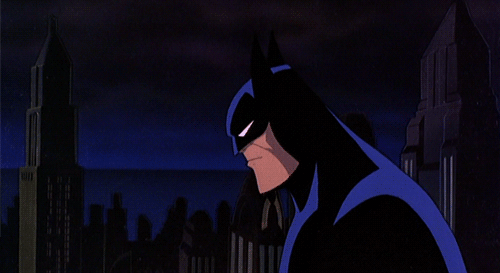
12.The Mark of Zorro
So I may be cheating here,as Diego is actually not Zorro all that much in this movie,but I think it counts.I adore this movie ,showing really how cunning Zorro is ,seeming to just be a rich idiot but making a fool out of his foes ,.Plus it has one of the best fight scenes of any movie ever,as the sword fight against Diego and Captain Pasquale is truly epic

@cinefantastiquemitho @filmcityworld1 @inevermetapenguinididntlike
#the mark of zorro#the mask of zorro#batman#batman the movie#batman mask of the phantasm#superman the movie#spider-man: into the spider-verse#avengers infinity war#captain america: the first avenger#the crow#wonder woman#logan
31 notes
·
View notes
Text
Capsule Reviews, February 2021
Here's some things I've been reading.
The Curse of Brimstone
DC's New Age of Heroes books, emerging from the beginning of Scott Snyder's creative-flameout-as-crossover-event Metal, mostly constituted riffs on Marvel heroes like the Fantastic Four (in The Terrifics) or the Hulk (in Damage). The Curse of Brimstone is a riff on Ghost Rider. It's... uneven. The first volume is generally pretty good, and when Phillip Tan is drawing it, as he does the first three and a half issues, it's gorgeous and unique, when he departs though, the quality takes a nose dive. None of the replacement artists, including the great Denis Cowan, can quite fill his shoes, and the story gets old fast. Guy makes a deal with the devil (or rather, a devil-like inhabitant of the "Dark Multiverse" as a not horribly handled tie-in to the conceits of Metal), realizes it's a raw deal, and rebels. The characters are flat, lots of time is spent with the main character's sister haranguing him to not use his powers (it is, in my humble opinion, something of a cardinal sin to have a character whose primary role is telling other characters to stop doing interesting things), too many potboiler "I know you're still in there!/I can feel this power consuming me!" exchanges, a couple of underwhelming guest spots (including a genuinely pointless appearance by the old, white, boring Doctor Fate) too many flashbacks, and not enough of the action. There's potential in the classic demonic hero rebelling plotline and its link to the liminal spaces of the DC universe, forgotten towns and economic depression, but the wheels come off this series pretty much as soon as Tan leaves. The really disappointing this is that the series is clearly built as an artistic showcase, so after Tan's shockingly early departure, the main appeal of the series is gone and there's nothing left but the playing out of an obviously threadbare story.
Star Wars - Boba Fett: Death, Lies, and Treachery
I don't care much about Star Wars these days, and I think that most of the old Expanded Universe was, as evidenced by Crimson Empire, pretty bad. Death, Lies, and Treachery, is that rare Star Wars EU comic which is actually good. John Wagner writes and he's in full-on 2000 AD mode, writing Boba Fett as a slightly more unpleasant Johnny Alpha (who is like a mercenary Judge Dredd, for those unfamiliar) right on down to the appearance of a funny alien sidekick for one of the characters. The main attraction is Cam Kennedy's art though, along with his inimitable colors: this might be the best looking Star Wars comic ever. The designs are all weird and chunky, with an almost kitbashed feeling that captures the lived in aesthetic of classic Star Wars, and the colors are one of a kind. Natural, neutral white light does not exist in this comic, everything is always bathed at all times in lurid greens or yellows, occasionally reds, and it looks incredible. In terms of "Expanded Universe" material for Star Wars, this hits the sweet spot of looking and feeling of a piece, but exploring the edges of the concept with a unique voice. It's great. I read this digitally, but I'd consider it a must-buy in print if I ever get the chance at a deal.
Zaroff
Zaroff is a French comic (novel? novella?). It's like 90 pages and it delivers exactly on its premise of "Die Hard starring the bad guy from The Most Dangerous Game." It's pretty good. Count Zaroff, he of the habitual hunting of humans, turns out to have killed a mafia don at some point, and after miraculously escaping his own seeming death at the end of the original story, finds himself hunted by the irate associates of this gangster, who have brought along Zaroff's sister and her kids to spice things up. Zaroff not only finds himself the hunt, but he also has to protect his estranged family as they struggle to survive. Nothing about this book or its twists and turns is likely to surprise you, but I don't think being surprised is always necessary for quality. Zaroff delivers on pulpy, early-20th century jungle action, is gorgeously rendered, and the fact that Zaroff himself is an unrepentant villain adds just enough of an unexpected element to the proceedings and character dynamics that it doesn't feel rote. There's a couple of points, ones typical of Eurocomics, which spark a slight sour note, such as some "period appropriate" racism and flashes of the male gaze, but for the most part these are relatively contained. It's good.
Batman: Gothic
Long before Grant Morrison did their Bat-epic, they wrote Batman: Gothic, an entirely different, but then again maybe not so different, kind of thing. It starts off with what must be called a riff on Fritz Lang's film, M, only where that story ends with a crew of gangsters deciding they cannot pass moral judgment on a deranged child-murderer, in Morrison's story they go ahead and kill him, only for the killer to return years later to rather horribly murder all of them as a warmup for a grandiose scheme involving unleashing a weaponized form of the bubonic plague on Gotham City as an offering to Satan. Along the way it turns out that said villain, one Mr. Whisper, is a former schoolmaster of Bruce Wayne's, who terrified the young Batman in the days before his parent's deaths. It's an earlier Morrison story and it shows. Certain elements presage their later Batman work; Mr. Whisper as a satanic enemy recalls the later Doctor Hurt, and the cathedral Mr. Whisper built to harvest souls recalls what writers like Morrison, Milligan, and Snyder would do concerning Gotham as a whole years later.The art, by Klaus Janson, is spectacular. If you're familiar at all with his work collaborating with Frank Miller you'll see him continuing in a similar vein and it's all quite good, even when he stretches beyond the street milieu which most readers might know him from. There's one particular sequence where Janson renders a needlessly complicated Rube Goldberg machine in motion that manages to work despite being static images. The writing by Morrison though, is not their finest. The M riff doesn't last as long as it could, and Mr. Whisper's turn in the latter half of the story from delicious creepy wraith to a cackling mass murderer who puts Batman in an easily escaped death trap feels like something of a letdown from the promise of the first half of the book. Gothic is good, but not, in my opinion, great. It's certainly worth checking out for Morrison fans however, and I imagine that someone well-versed in his latter Batman stuff might be able to find some real resonance between the two.
Green Arrow: The Longbow Hunters
For a long, long time, Longbow Hunters was THE Green Arrow story. It is to Green Arrow as TDKR is to Batman, deliberately so. Mike Grell wrote and drew the reinvention of the character from his role as the Justice League's resident limousine liberal to a gritty urban vigilante operating in Seattle over the course of these three issues, which he'd follow up with a subsequent ongoing. Going back to it, it certainly merits its reputation, but its far from timeless. Grell's art is unimpeachable absolutely incredible, with great splashes and spreads, subtle colors, and really great figure work. The narrative is almost so 80's it hurts though, revolving around West Coast serial killers, cocaine, the CIA and the Iran-Contra scandal, and the Yakuza, and it's hard to look back at some of this stuff without smirking. The story begins with a teenager strung out on tainted coke sprinting through a window in a scene that's right out of Reefer Madness. In the cold light of a day 30+ years later, parts of it look more than a little silly. The 80's-ness of it all doesn't stop with that stuff though, even the superhero elements smack of it. Green Arrow realizes that he's lost a step and has be to be shown a way forward by an Asian woman skilled in the martial arts (recalling Vic Sage's reinvention in the pages of The Question), and Black Canary gets captured and torture off-panel for the sake of showing that this is real crime now, not the superhero silliness they've dealt with before. The treatment of Black Canary here is pretty markedly heinous, it's a classic fridging and Grell's claims that he didn't intentionally imply sexual assault in his depiction of her torture is probably true, but still feels more than a little weak considering how he chose to render it.The final analysis is that this book is good, but it exists strictly in the frame of the 1980's. If you're a fan of Green Arrow, there are worse books to pick up, or if you're interested in that era of DC Comics it's more than worth it, but as a matter of general interest I wouldn't recommend it very highly.
SHIELD by Steranko
Jim Steranko is sort of the prodigy of the early Marvel years, a young guy who came up through the system, blossomed into an incredible talent, and then left the company, and by and large the industry, behind. He would go on to dabble in publishing, work in other mediums, and generally kick around as the prodigal son of Marvel Comics. This collection, of both his Nick Fury shorts in the pages of Strange Tales and the four issues he drew of the original Nick Fury solo series, charts Steranko's growth as an artist. The book starts off with Steranko working from Jack Kirby's layouts with Stan Lee's dialogue and writing, and Steranko might be the one guy in history for whom working off of Kirby's blueprints is clearly holding him back. The first third or so of this collection really isn't much to write home about, as Steranko is obviously constrained by someone else's style, and at the end of the day those early stories still read as somewhat uninspired pulp compared to the highlights of early Marvel. There are flashes though, of techniques and ideas, which foreshadow what Steranko is capable of, and when he finally takes over as solo writer/artist it's like he's been unleashed. He immediately has Nick Fury tear off his shirt and start throwing guys around over psychedelic effects. He writes out most of Kirby and Lee's frankly uninspired boys' club supporting cast, he makes Fury visibly older, wearier, but also so much cooler. It's the birth of Nick Fury as a distinctly comic book super spy.By the time he finishes wrapping up the previous writers' plotline with Hydra and Baron von Strucker, Steranko is firing on all cylinders. By the time it gets to Steranko's Fury solo series, he's somehow surpassed himself, turning in effects, panel structures, and weird stories which make the earlier installment about a suit-wearing Man from UNCLE knockoff and its strict six-panel layouts look absolutely fossilized.I can't recommend this collection highly enough for any fan of the artform, even if the stories themselves might not be everyone's cup of tear. It's truly incredible to watch Steranko emerge as an artist over the course of this single collection. The book itself has a few problems, it's not the most elegantly designed in its supporting materials and index, but the content of it more than outweighs that. It's great stuff.
3 notes
·
View notes
Note
How's your halloween day going? Also, what are your favourite halloween things (candy, costume, movie, horror story)?
Eh, s’been a quiet enough one. Dropped our ballots off today, though! :D
SCARY’S FAVORITE HALLOWEEN GOODIES
Candy: Jolly Ranchers. Any Jolly Rancher. Old Lady who used to hand out two, I still remember you.
Costume: I went as a gangster girl one year, that was fun. I haven’t really got one, to be honest.
Movie: Silence of the Lambs is a classic, but I, personally, am watching Halloween this year. (It’s that moon!)
Story: I spent my childhood being scarred by the original illustrations of Scary Stories to Tell in the Dark, Slappy the Dummy, and Wishbone’s Tails of Terror. :p Gotta be honest, though, Batman: Gothic was genuinely freaky, and Red Dragon messed me UP.
3 notes
·
View notes
Text
quarantine movie asks
tagged by: @silverscene - thank you very much!
favorite movie: oof, it changes but i think for now i’ll go with either cat on a hot tin roof (1958) or the clock (1945)
movie that makes you remember your childhood: victor victoria (1982). yeah my parents were pretty lax about me watching that sorta stuff. also, a hard day’s night! when i was first getting into the beatles.
favorite tom hanks movie: huh?
favorite disney movie: CINDERELLA. it’s just a childhood favorite of mine, with beautiful animation and such lovely music.
movie that makes you cry: the red shoes (1948). i saw it not too long ago for the first time and ended up a sobbing mess. oh, and the original a star is born.
favorite 80s movie: heathers (1988). it’s a lot of fun and has some really interesting societal commentary alongside the black comedy, too
favorite comedy: BRINGING UP BABY (1938). “i just went GAY all of a sudden!” that movie is just one line after another of some of the funniest stuff i have ever seen.
favorite sports movie: dodgeball (2004). it’s really stupid and i love it. no comment.
favorite courtroom movie: witness for the prosecution (1957). it’s my first tyrone power movie so of course it holds a special place in my heart. also it’s just really, really good.
favorite horror movie: ...i don’t watch horror films because i know i’d be really easily scared by them. so, no comment.
most overrated movie: hmm. black swan (2010). maybe this is because i saw its predecessor the red shoes, but i really couldn’t get the appeal to this one (also maybe because i’m not that big a fan of natalie portman, so-)
favorite gangster movie: goodfellas (1990). it’s scorsese, how could i not enjoy it?
favorite war movie: the dawn patrol (1938). this film ALSO made me cry ;A;
movie you can watch over and over again: too many to pick! i will say that among them, though, are young frankenstein, the harvey girls, the lady from shanghai, and father of the bride.
movie with the best soundtrack: MEET ME IN ST. LOUIS. the trolley song slaps. do i really need to say more?
favorite christmas movie: elf (2003).
movie you’re embarrassed that you love: none, really? i personally just let myself enjoy things.
favorite sequel: i don’t watch enough sequel films to say.
favorite period drama: crimson peak (2015). i know, i know. technically it’s more of a gothic romance than a period drama, but those historically accurate costumes, amirite?
favorite dc movie: the dark knight (2008).
favorite movie quote:
"you speak treason.” “fluently.” from robin hood (1939).
tagging: @avantegarda / @ollieoxen-free / @hildy-dont-be-hasty
2 notes
·
View notes
Text
5 Criminally Underrated Alan Parker Movies You Need to See
https://ift.tt/3a5pCp0
A working-class Londoner who started out in advertising, Parker knew how to play to the crowd but wasn’t afraid to take risks or challenge convention.
That was evident from his feature debut, Bugsy Malone, an inspired pastiche of Hollywood gangster films that saw Parker defy genre norms with the recruitment of an all-child cast wielding ‘Splurge’ guns firing whipped cream instead of bullets.
It was a decision that drew anger in some quarters with noted critic John Simon famously branding the film “an outrage” in New York Magazine.
“Wholesome youngsters have been duped into acting like adults,” he said, “stupid, brutal, criminal adults, at that.”
Bugsy Malone flopped in the US but Parker soon established himself stateside with Midnight Express and Fame, two box office hits and examples of Parker’s unrivalled versatility and habit of defying expectations.
In time, Bugsy Malone enjoyed critical reappraisal, emerging as a firm favourite with audiences on both sides of the Atlantic.
Over a varied and wide-ranging career, Parker is often remembered for crowd-pleasing efforts like The Commitments and Evita.
However, arguably his most fascinating work came when he took risks – as these five films attest.
Shoot the Moon
After the success of Fame, Parker was brought back down to earth with this underappreciated family drama which bombed at the box office despite earning rave reviews from critics.
Based on an early script from One Flew Over the Cuckoo’s Nest screenwriter Bo Goldman, Shoot the Moon centered on the crumbling marriage of George and Faith Dunlap and the impact their eventual separation has on their four children.
Goldman had unsuccessfully, pitched the movie to several major studios for nearly a decade before Parker got involved.
Together, they rewrote the script, drawing from personal experiences to depict the film’s deteriorating relationships and, crucially, recruited Albert Finney and Diane Keaton to star as George and Faith, respectively.
Arriving at a time when films like Ordinary People and Kramer vs Kramer were bringing divorce and family dysfunction to multiplexes, Parker’s film unfairly ended up lost in the shuffle.
It remains a powerful, if at times, deliberately difficult watch, bolstered by career-best turns from Finney and Keaton, whose emotionally raw performances earned them both Golden Globe nominations.
Birdy
Adapted from William Wharton’s acclaimed novel of the same name, Birdy was one of the first films to address the horrors of Vietnam, pre-dating the likes of Platoon and Born on the Fourth of July.
Matthew Modine stars as Birdy, a serial daydreamer left mentally shattered by Vietnam, who spends his days couped up in a mental hospital acting like a parakeet, visited daily by his wounded best friend Al (a young Nicolas Cage) who is determined to bring him back to reality.
Modine originally read for the role of Al by was convinced to take on the role of Birdy by Parker who correctly identified a “”introverted honest quality” to the star that was essential to making the character, who remains monosyllabic for much of the film, an endearing protagonist.
Told out of chronological order through flashbacks, Parker’s film is a dizzying odyssey through a damaged mind, addressing themes of friendship, obsession and the impact of trauma.
The filmmaker deploys a bag of tricks to bring this unique tale to life – Birdy is notable for being the first film to utilise Skycam technology, a computer-controlled cable-suspended camera system used to capture the moment Birdy imagines taking flight.
The result is his most complex and rewarding film, one that won the Grand Prix Spécial du Jury prize at the 1985 Cannes Film Festival.
Angel Heart
Like many of the surprise turns in Parker’s eclectic career, Angel Heart was greeted with mixed reviews and middling box office returns upon release in 1987.
That perception changed in the years that followed, with many now regarding it as Parker’s best film and certainly Mickey Rourke’s best performance.
Rourke is at his mesmerising best as Harry Angel, a 1950s private eye hired by Robert De Niro’s mysterious Louis Cyphre to track down a pop singer who owes a substantial debt.
As Angel’s investigation continues, however,it becomes apparent that something sinister is afoot, with every possible witness or lead ending up the victim of bloody, ritualistic murder.
Read more
Movies
Revisiting Alan Parker’s Angel Heart
By Brogan Morris
Movies
Looking Back at Angel Heart
By Tony Sokol
Adapted from William Hjortsberg’s 1978 novel Falling Angel, Parker script saw the action move from the book’s original setting of New York to New Orleans.
That proved something of a masterstroke, imbuing the film’s already distinctive blend of film noir thriller and Satanic horror with a decaying Southern Gothic feel.
Though a controversial sex scene involving pints and pints of blood feels a touch unnecessary when watching the film back, Angel Heart is near enough a masterpiece; a moody, psychological thriller that has influenced countless filmmakers, with Christopher Nolan one noted admirer.
Mississippi Burning
Parker made a habit of playing fast and loose with the facts when it came to adapting non-fiction. Midnight Express previously drew criticism for its portrayal ofvTurkish characters, as well as for deviating from survivor Billy Hayes’ real-life story. However, it remains an engaging piece of filmmaking.
It’s a similar story with Mississippi Burning, which purports to be based on a real-life investigation into the killings of three civil rights activists in 1964 America but proved more fiction than fact and suffered at the hands of many critics as a result.
Leaving aside the debates over the film’s authenticity, Mississippi Burning still succeeds in shining a light on a dark period in American history, albeit from a distinctly white perspective.
It’s a vividly realised depiction of 1960s America, full of striking imagery that touches on issues of segregation in the south and the looming spectre of the Ku Klux Klan and its burning crosses.
While Gene Hackman and Willem Dafoe prove a magnetic duo as the film’s central pairing of older, more cynical, FBI agent and his younger, idealistic charge, the standout performance comes from Frances McDormand as the local deputy sheriff’s downtrodden housewife.
Come See the Paradise
Come See the Paradise divided critics upon release but is worth seeking out, at the very least for the fact it remains one of the only major studio movies to focus on the Japanese-American internment camps of the Second World War.
Dismissed by some as a sappy love story, Parker’s movie is more ambitious and complex than that; an interracial romance set against the backdrop of one of the most complex and ethically charged periods in American history.
A vividly-realised period piece, Dennis Quaid does solid work as Jack McGurn, the Irish-American projectionist who falls for his Japanese-American boss’s daughter only for them to end up separated in the ensuing conflict.
However, it’s the film’s other star-crossed lover, Tamlyn Tomita’s Lily, who proves most fascinating. Best known for The Karate Kid Part II at the time, Come See the Paradise had a personal edge for Tomita, whose father spent time in a real California internment camp.
Through Lily, Parker presents the stark human injustice faced by the interned, people who not only lost civil liberties but also their sense of identity. It’s just a shame Tomita is not afforded nearly as much screen time as Quaid.
The post 5 Criminally Underrated Alan Parker Movies You Need to See appeared first on Den of Geek.
from Den of Geek https://ift.tt/31tX98t
1 note
·
View note